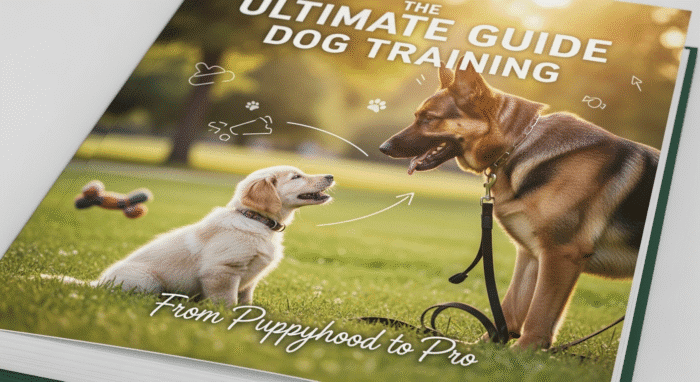Okay, let’s be honest. When I first got my golden retriever, Charlie, I pictured idyllic walks in the park, a perfectly behaved companion, and maybe even a few impressive tricks. What I actually got was a furry landshark who specialized in chewing furniture and staging impromptu escape attempts. Ah, puppyhood. But here’s the thing – it doesn’t have to be that way (or at least, not entirely). Dog training, whether you’re dealing with a rambunctious puppy or an older dog with a few quirks, is totally achievable. You just need the right approach, a whole lot of patience, and maybe a sense of humor. This isn’t just about teaching your dog to sit; it’s about building a real connection, a bond built on trust and mutual understanding. And trust me, that’s worth more than any perfectly executed ‘fetch’. I’m here to tell you it’s 100% doable, but it requires consistency, patience, and a willingness to learn alongside your furry friend.
This guide? It’s not some sterile, step-by-step manual. It’s more like a conversation with a friend who’s been there, chewed-up slippers and all. I mean, who better to guide you than someone who’s personally navigated the ups and downs of dog ownership?
Table of Contents
Understanding Your Dog’s Learning Style

You might be wondering, “Okay, great, but where do I even start?” Well, before you dive headfirst into commands and clicker training, it’s crucial to understand that every dog learns differently. Just like people! Some dogs are highly motivated by food (Charlie definitely falls into this category). Others are all about praise, while some respond best to toys or play. And while we’re at it, you should explore a wide range of dog breeds. Learn more here.
Spend some time observing your dog. What gets their tail wagging? What makes them perk up their ears? What do they seem to genuinely enjoy? These are your keys to unlocking their learning potential.
Actually, that’s not quite right. There’s something even more interesting here. It’s not just what motivates them, but how they process information. Are they visual learners? Auditory learners? Do they need lots of repetition? Experiment with different training methods and see what clicks (pun intended!). You will find that some dogs respond better to clicker training, while others respond better to treats or verbal praise. Find out what works for your dog!
The Power of Positive Reinforcement
This is where things get really interesting. Forget the old-school methods of punishment and dominance. Those are outdated, ineffective, and frankly, kind of mean. The future of dog training is all about positive reinforcement. And by the way, here’s some awesome tips for taking your dog to the beach.
Positive reinforcement basically means rewarding your dog for desired behaviors. Did they sit when you asked? Treat! Did they come when called? Praise and a belly rub! The idea is to make learning fun and rewarding, so your dog is actually excited to participate.
Here’s the thing: timing is everything. The reward needs to be delivered within a few seconds of the desired behavior for your dog to make the connection. And it needs to be something your dog actually wants. A pat on the head might be nice, but if they’re really craving a tasty treat, that’s what’s going to be most effective.
But – and this is a big but – don’t overdo it with the treats! You don’t want to end up with an overweight dog. Use small, healthy treats and gradually phase them out as your dog masters the commands. Eventually, praise and affection should be enough.
And let’s not forget about consistency. Use the same commands, the same hand signals, and the same tone of voice every time. This will help your dog understand what you’re asking and avoid confusion.
Addressing Common Dog Training Challenges
Let’s get real – dog training isn’t always sunshine and rainbows. There will be times when you feel like you’re banging your head against a brick wall. But don’t despair! Every dog owner faces challenges. Here are a few of the most common, and how to overcome them:
- Excessive Barking: The frustrating thing about this is that there’s usually an underlying cause. Are they bored? Anxious? Territorial? Figure out the trigger and address it. Provide more exercise, mental stimulation, or create a safe space for them to retreat to.
- Chewing: Puppies chew. It’s a fact of life. But you can redirect this behavior by providing plenty of appropriate chew toys. Make sure anything you don’t want chewed is out of reach.
- Pulling on the Leash: This is a common problem, but it’s easily solved with a little training. Use a front-clip harness or a head halter to give you more control. Practice loose-leash walking in a quiet area, rewarding your dog for staying by your side.
- Housebreaking Accidents: Accidents happen, especially with puppies. But if your dog is consistently having accidents in the house, it could be a sign of a medical problem. Consult with your veterinarian to rule out any underlying issues.
I keep coming back to this point because it’s crucial: patience is key. Don’t get discouraged if your dog doesn’t learn a command overnight. Keep practicing, keep reinforcing positive behaviors, and celebrate small victories. Trust me, it’s worth it.
And hey, if you’re struggling, don’t be afraid to seek help from a professional dog trainer or behaviorist. They can provide personalized guidance and help you address any specific challenges you’re facing. Or you could try Crazy Games on your phone. Crazy Games is a fun gaming site.
The Ongoing Journey of Dog Training
Dog training isn’t a one-time event; it’s an ongoing journey. Even after your dog has mastered the basics, it’s important to continue practicing and reinforcing their training. This will help them stay sharp and prevent them from developing bad habits.
Think of it this way: you wouldn’t expect to learn a new language and then never speak it again, would you? The same goes for dog training. Consistency is key to maintaining a well-behaved and happy companion.
And speaking of happy companions, don’t forget to have fun! Dog training should be an enjoyable experience for both you and your dog. Make it a game, celebrate successes, and enjoy the bond you’re building together. That’s what it’s all about.
FAQ: Your Dog Training Questions Answered
How do I know if my dog is ready to start training?
That’s a great question! Honestly, you can start training as soon as you bring your puppy home. Even very young puppies can learn basic commands like ‘sit’ and ‘stay’ using positive reinforcement. For older dogs, it’s never too late to start training, but it might take a little more patience and consistency. The key is to start slow, keep it positive, and adjust your approach based on your dog’s individual learning style. I’ve seen some pretty stubborn dogs turn into model citizens with the right techniques. The critical element is positive reinforcement.
Why isn’t my dog listening to me?
There are several reasons why your dog might not be listening. Are you being consistent with your commands? Are you using positive reinforcement? Is your dog distracted by something in the environment? Make sure you’re using clear, concise commands and rewarding your dog for good behavior. Minimize distractions and try training in a quiet area. If your dog is consistently ignoring you, it might be a sign of a deeper issue, such as anxiety or fear. Consulting with a professional dog trainer or behaviorist can help you identify the root cause of the problem and develop a plan to address it.
What’s the best way to deal with problem behaviors like barking or chewing?
Addressing problem behaviors requires a bit of detective work. You need to figure out what’s causing the behavior in the first place. Is your dog bored? Anxious? Trying to get your attention? Once you know the cause, you can start to address it. Provide more exercise and mental stimulation to combat boredom. Create a safe space for your dog to retreat to if they’re feeling anxious. And redirect unwanted behaviors with positive reinforcement. For example, if your dog is chewing on your shoes, give them a chew toy instead. The key is to be patient, consistent, and address the underlying cause of the behavior.
How long does it take to train a dog?
This is a common question, and the answer is… it depends! It depends on your dog’s breed, age, temperament, and your own consistency as a trainer. Some dogs pick up commands quickly, while others take more time. The important thing is to be patient and celebrate small victories. Even if your dog doesn’t master a command overnight, the effort you’re putting in is strengthening your bond and building a foundation of trust. Plus, you’re getting exercise. And that’s always a win-win!

